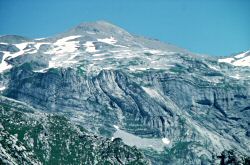 Fold-thrust relationships
Fold-thrust relationships  Fold-thrust relationships
Fold-thrust relationships The relationships between folds and thrusts have been investigated for almost as long as geologists have been interpreting the tectonics of mountain belts. Early Alpine debates centered on the notion that folding was a necessary precursor and associate of thrust displacement, captured in the influential diagrams of Heim and others in the Swiss Alps. In the 1930s, John Rich famously interpreted the Powell Valley anticline in the Appalachians as having formed because of simple displacement of a thrust (the Pine Mountain ) up a ramp-flat profile. Since that insight there have been various attempts to quantify the relationships between thrust shape and fold geometry – the most influential being John Suppe's (1983) study. Since that time there has been a tendency to classify structures as being:
But are these idealised behaviours really that applicable? Studies using outcrop coupled with growth strata (that reveal that incremental evolution of structures) generally imply tectonic histories for folds that do not conform to the ideal models. Getting it right matters, not so much for understanding regional-scale structural evolution, but to develop appropriate mechanical models of faulting and folding and to relate small-scale structures to the larger scale. This latter point is key for commercial applications – in assessing the dimensions and structural history of hydrocarbon prospects for example.
(pdfs available where the text is live).
Butler, R.W.H. 1982. Hanging-wall strain: a function of duplex shape and footwall topography. Tectonophysics 88, 235-246.
Butler, R.W.H. 1992. Evolution of Alpine fold-thrust complexes: a linked kinematic approach. In: Structural geology of fold and thrust belts (ed. S. Mitra & G. Fisher) Johns Hopkins University Press, Baltimore, 29-44.
Butler, R.W.H. 1992. Structural evolution of the western Chartreuse fold-thrust system, NW French Subalpine chains. In: Thrust Tectonics (ed. K.R. McClay) Chapman & Hall, 287-298.
Butler, R.W.H. & Bowler, S. 1995. Local displacement rate cycles in the life of a fold-thrust belt. Terra Nova 7, 408-416.
Butler, R.W.H. & McCaffrey, W.D. 2004. Nature of thrust zones in deep water sand-shale sequences: outcrop examples from the Champsaur sandstones of SE France. Marine and Petroleum Geology 21, 911-921.
Casey, M. & Butler, R.W.H. 2004. Modelling approaches to understanding fold development: implications for hydrocarbon reservoirs. Marine and Petroleum Geology 21 933-946.
Image caption: Part of a fold-thrust complex developed in Upper Jurassic limestones in the Haut Giffre area of the Subalpine thrust belt (Morcles nappe in France). About 1 km visible topography, although the higher ground is strongly foreshortened.
|| Thrusts || Rob Butler ||